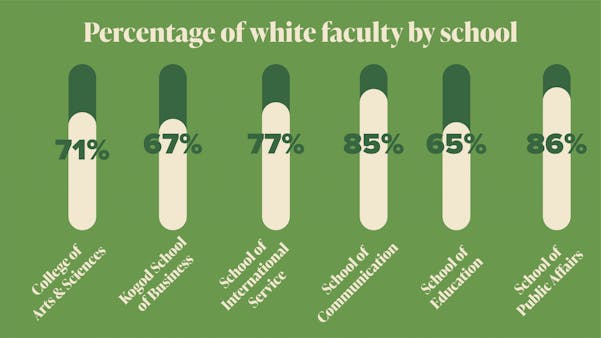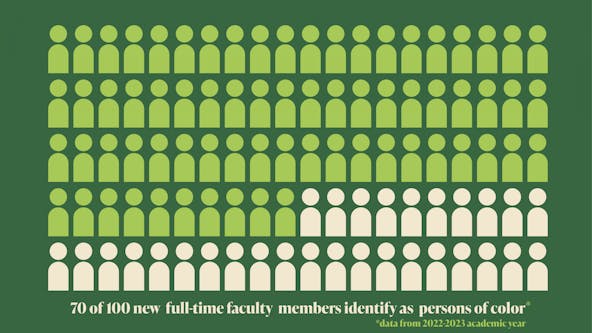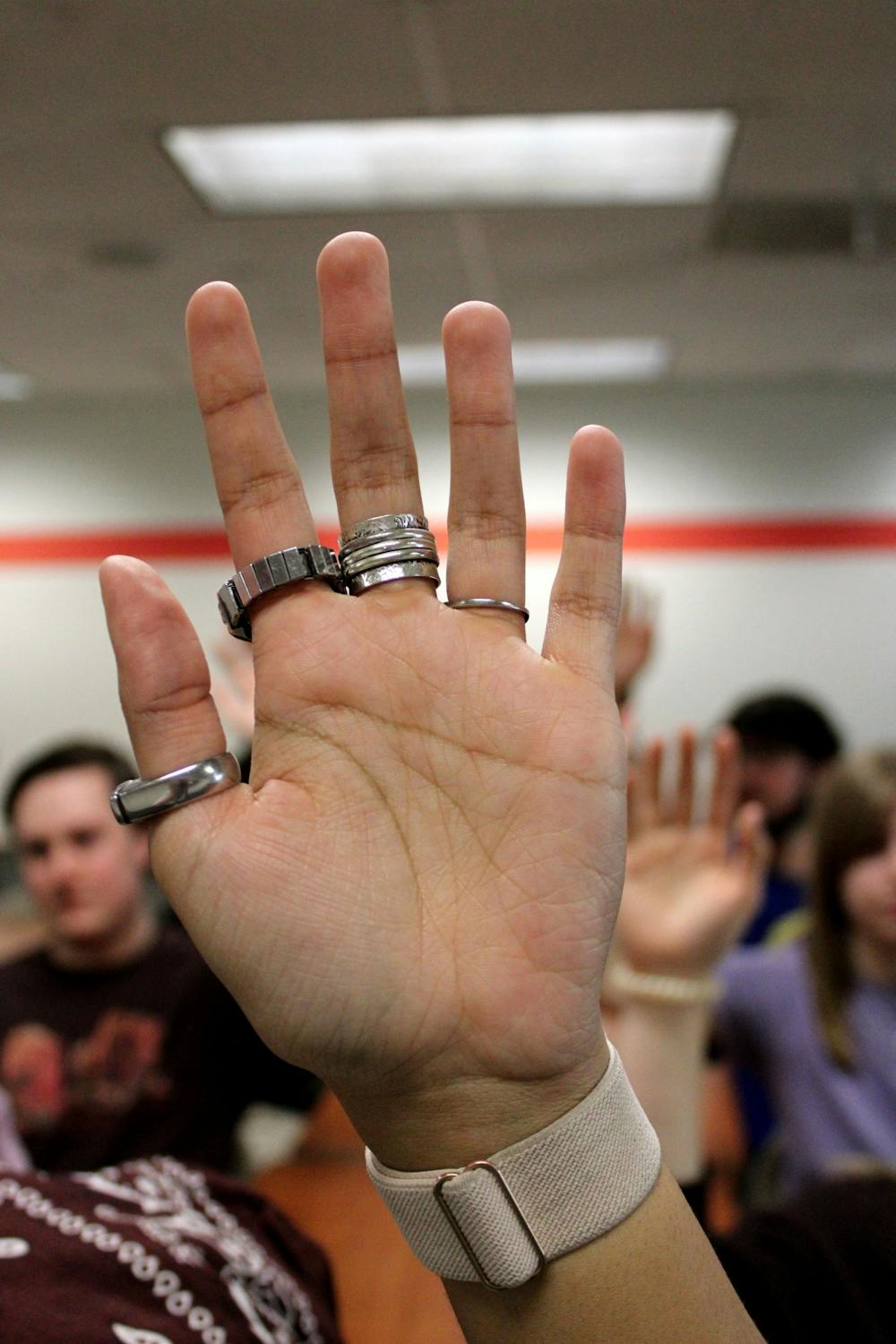From the Newsstands: This story appeared in our Spring 2023 print edition. You can find the digital version here.
Veronica Botero arrived at American University with high expectations for faculty diversity. Going to a predominantly white high school where the only Hispanic faculty taught Spanish, she hoped to have a new experience at AU.
Botero, a freshman in the School of Public Affairs and the freshmen liaison for Latinos En Acción, hoped to find a Hispanic law professor that she could look up to as a positive role model, to show that her career aspirations were possible. Based on the information she received during her admissions tour and in emails from the University, Botero entered AU with expectations for representation that haven’t been met yet.
“I really have limited options when it comes to me, because as much as I might connect to a white professor, there's no deeper connection than being able to relate to an ethnicity,” Botero said.
Some students said they feel that despite being labeled the most liberal college in the country, AU falls short of student expectations and needs in terms of faculty diversity.
Both students of color and white students noticed differences in faculty diversity based on what school their major fell under. A student in the Kogod School of Business, of which 32 percent of full time faculty identified as persons of color, has a higher chance of having a full-time professor of color compared to a student in the School of Communication, which has nearly half as many full-time faculty of color at 15 percent, according to an analysis by The Eagle of data from the 2021-2022 Academic Data Reference Book.
While some have noticed progress, students and faculty both said that there is still work to be done. Since 2017, the percentage of full-time nonwhite faculty has increased by a little over two percent, according to the Reference Book, which includes Middle Eastern as white.
Discrepancies in faculty diversity
Daniel Punales, a sophomore in the College of Arts and Sciences and SPA and a first-generation college student, said he has noticed different levels of faculty diversity based on the department his classes are associated with. SPA has 15 percent more white full-time faculty than CAS, according to the Reference Book.
“I've had different interactions with different departments. So it's not equal across the board, but like, some are better than others, like I say,” Punales said.
Similarly, Isabella Macchia, a sophomore in the School of International Service, said she thinks she has had an almost equal number of white and nonwhite professors but believes this is because of her major, which requires her to take language courses. According to the Reference Book, SIS had the third highest percentage of white full-time faculty at 77.17 percent in 2022.
“I definitely think it's an SIS thing,” Macchia said. “And I take Japanese, and so my Japanese professor both semesters freshman year was a Japanese woman, which I feel like is also important because you need to understand like that cultural complexity as well.”
Data from the Academic Data Reference Book shows that SPA has the highest percentage of white full-time faculty at 86.49 percent, whereas the School of Education has the lowest percentage at 65.38 percent. There was no data provided on part-time faculty.

Qudsia Saeed, a junior in the School of Education, noticed more diversity in the professors she has in SOE than in other schools she has taken classes in. However, she said that her peers not majoring in education also care about how they’re learning and who they’re learning from.
Saeed said that terms used by the University like “inclusive excellence” feel like buzzwords for marketing rather than actual efforts to prioritize diversity. When it comes to diversity and representation, Saeed says there still isn’t enough progress. “We’re more than a business transaction,” Saeed said.
Administering ‘Inclusive Excellence’ and diversifying hiring
The AU Plan for Inclusive Excellence works to increase inclusivity and improve the campus climate. It began as a result of the 2017 Campus Climate Survey, which revealed significant differences in the campus experiences of people of color compared to white people.
Inclusive Excellence is a framework developed by the Association of American Colleges and Universities in 2005. The University is currently in Phase Two of the plan, which focuses on advancing racial equity. According to Jasmine Pelaez, AU’s internal communication manager, President Sylvia Burwell introduced the AU Plan for Inclusive Excellence in 2018 “to address issues of inequality on our campus and build a culture of inclusion, in collaboration with university leadership, staff, and faculty members.”
LaTanya Sothern, the new president of the AU Alumni Association, graduated in 1992 from SOC and CAS. She said the Plan for Inclusive Excellence is embedded in everything the Alumni Board does.
Sothern praised President Sylvia Burwell as the most accessible president of AU so far to alumni.
“President Sylvia Burwell, since the day she has arrived, has done nothing but demonstrate he dedication and commitment not to just talking about inclusivity but also really turning the knob from you know, her executive council all the way through to making sure that inclusivity and inclusive excellence was a part of what we do,” Sothern said.
According to Pelaez, the hiring process at AU begins with the establishment of a search committee, which is required to schedule a diversity, equity and inclusion workshop with the dean of faculty.
The open faculty position is posted on job boards and networks and the selected faculty member is onboarded with an orientation. The University is currently in the final stages of developing AU’s first guide to inclusive hiring.
Kelli Frias, an assistant professor of marketing in Kogod and faculty representative on the board for the Latino & Hispanic Faculty and Staff Affinity Group, began working at AU in 2019. She has participated in numerous hiring committees and discussions on strategic planning.
“We often talk about the front of the classroom needing to look like the back of the classroom,” Frias said.
The marketing department within Kogod uses The PhD Project, an organization working to increase workplace diversity by increasing the number of diverse faculty in business schools, to recruit new faculty. Frias said she participated in the program as a doctoral student and was probably the 13th “Hispanic or Hispanic female” faculty member in the country in marketing when she exited the program.
“I would like others to know that there's opportunities and there's a place for you and that it's needed, much needed,” Frias said. “And I think it benefits what we talk about, what we teach, and the student experience.”
Ying-Chen Peng, an assistant professor in the Department of Art, said that diversity, equity and inclusion is a very important factor in CAS in hiring new staff and faculty.
“When we talk about whether this person is a good fit to our program, or our department, we definitely put the cultural heritage and adapters and scholarship into account,” Peng said.
Peng is also a co-chair of the newly approved Asian American, Native Hawaiian and Pacific Islander Faculty and Staff Affinity Group. The group was created in response to AU’s vocal and ongoing commitment to diversity and inclusiveness, according to Anna Fung, an assistant pro- fessor in Kogod’s Department of Management, who is also a co-chair of the affinity group. One of their goals is to provide a platform to faculty to share resources to better serve the AUcommunity and AAPI students, Fung said.
“Some faculty members actually help bring out the voices that used to be overlooked. And their presence itself would definitely greatly encourage student participation and engagement,” Peng said. “So I think, at AU, the faculty diversity is definitely a big issue that we're working very hard on making improvement.”
Selene Malench, a sophomore in SIS and CAS and the alumni relations director for the Asian American Student Union believes that faculty diversity is still not made a priority, but also feels that AU has made more of an effort in recent years.
“I feel like that has really shone through with the new hires that we get and the different deans of different schools. But that being said, AU is still a predominantly white institution. So they have made progress. I think they still have a lot of work to do,” Malench said.
Sense of belonging
The University is measuring the Plan’s progress by looking for improvements in the Campus Climate Survey data. According to the measuring progress section of the Plan for Inclusive Excellence, in the Campus Climate Survey results for 2023, AU hopes to have “at least 70 percent of students, faculty, and staff feel[ing] that AU is committed to creating a campus where everyone has a sense of belonging,” which would be a 12 percent increase from undergraduate students and an 11 percent increase from faculty in 2019.

AU is a predominately white institution, with the undergraduate student population, both full and part time, consisting of just over 55 percent white students, according to data from the 2021 to 2022 Academic Data Reference Book. Many students of color said that they found community in student organizations and affinity groups.
Sofia Guerra Oropeza, a junior in CAS, is from Mexico City and is the vice president of the Mexican Club at AU. As an international student and a transfer student, she struggled to transition to U.S. schooling and felt more supported by students than by the administration.
“I do feel a sense of belonging, but it took time,” Guerra Oropeza said. “When I first transferred here, it was a very lonely process.”
Botero found belonging in student affinity groups and felt that AU did not help foster her sense of community. She believes her outgoing personality helped her find a community and people to relate to, but she said that process could be more difficult for students who are shy.
“But for the most part, I think it's been mainly on the students, especially minority students, to find their own niche, their own group, that they can relate to,” Botero said.
Students find importance in classroom representation
According to an assessment of the 2017 Campus Climate Survey, “students reported that it was important to see themselves reflected in the faculty and curriculum to create a sense of belonging and inclusiveness.”
After almost two years at AU, Oni Chaytor, co-president of Sister Sister, said this semester is the first time she’s had a Black female professor. The SOC sophomore said as an aspiring journalist, it is especially impactful having a Black professor in her journalism classes. Chaytor noticed that her white professors typically only brought in white guest speakers, which made it difficult for her to visualize herself working in a predominately white industry.
“It kind of discourages me from, like, asking for help in terms of, like, looking for opportunities, because I feel like they just wouldn’t really understand the type of, like, opportunities and internships I'm looking for as a Black woman,” Chaytor said.
During the 2022-2023 academic year, AU hired approximately 100 new full-time faculty members, 70 percent of whom self-identified as persons of color, according to Pelaez.
“As we continue to increase faculty diversity, we are also focused on retaining talented and diverse faculty members,” Pelaez said in an email, referencing a $1 million ADVANCE grant from the National Science Foundation to help AU retain faculty in underrepresented communities in STEM.
Botero has so far been disappointed by the reality at AU. Wanting to see someone like her at the front of the classroom was something she thought would happen at AU.
“A school like AU, which is notoriously known to be the most liberal school in the United States, should have a higher faculty diversity,” Botero said. “And it's not about being exclusionary to white people who are also qualified. It's about letting your students of color also be able to have mentors who are experts in their field, because the experts are there, we just need to look for them — we need to do a better job of hiring them.”





